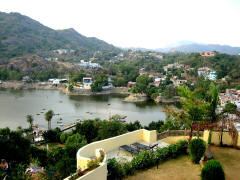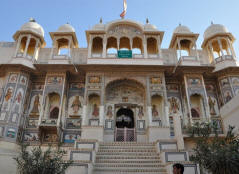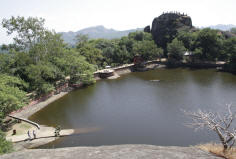



A pleasant retreat set amidst the lush forested hills, Mt. Abu is a
green oasis in the barren desertscape thats Rajasthan. Situated at the southern
tip of the Aravali range the hill retreat owes its cool climate to its rich
flora covering the entire hillside that includes coniferous trees and flowering
shrubs. The road leading to Mount Abu is a curved one characterized by arid
region dotted with huge rocks in weird shapes and high velocity winds. The only
hill station in Rajasthan, Mount Abu is more than just a summer retreat. Its
stunning array of exquisite Dilwara Jain Temples, dating back 11th- 13th
centuries, make it a popular pilgrimage centre. ‘Abu’ according to a legend
stands for the son of Himalaya, deriving its name from Arbuada,the powerful
serpent who rescued Nandi, the sacred bull of Lord Shiva, from a chasm.
Mount Abu has been home to many sages and saints. Most famous of them was Sage
Vashishtha who is believed to have created four agnikula Rajput clans from a
fire-pit by performing a ‘yagna’ or fire sacrifice, to protect the earth from
the demons.
The Yagna was performed besides a natural spring situated below Abu, emerging
from a rock shaped like a cow’s head and hence the site was called Gaumukh.
How To Reach
Air : Nearest airport is Udaipur, 185 kms.
Rail : Abu Road is the closest railhead linked with Ahmedabad, Delhi, Jaipur and
Jodhpur
Road :Good network of bus services connect Mount Abu to major cities of
Rajasthan and India.
Climate Conditions
Area 25 sq. km
Languages Rajasthani, Hindi, English
Altitude 1219 metres
What to See
Dilwara Jain Temple: These beautifully carved temples built between 11th and
13th century A.D. are sheer elegance in marble, dedicated to the jain
Tirthankaras. The Vimal Vasahi temple is the oldest of these dedicated to the
first Tirthankara. Built in 1031 A.D. (by Vimal Shah-a merchant and
representative of then Gujarat ruler), it is a superb example of temple
architecture.
The central shrine has an image of Rishabhdev and large courtyard with 52 small
shrines,each housing a beautiful statue of thirthankaras with 48 elegantly
carved pillars form the entrance to the courtyard.The Lun Vasahi Temple,
dedicated to the 22nd Tirthankaras-Neminath, was built in 1231 A.D. by two
brothers-Vastupal and Tejpal,Ministers of Raja Vir Dhawal, a ruler of
Gujarat-belonging to the Porwal Jain community.With door casings, pillars,
architraves and sculptures on porticos,the temple is a fine specimen of
craftsmanship
Museum and Art Gallery: Located at the Raj Bhawan, it was a collection of
archaeological excavations dating back to 8th-12th century A.D. It also has Jain
bronze carvings,brassworks etc. for viewing.
Gaumukh Temple: A natural spring flowing through a sculpted cow’s head gives the
shrine its name.The famous ‘yagna’ of sage Vashishtha was performed here. A
beautifully sculpted hill temple of Arbuada-the mighty serpent stands against
the beautiful backdrop. Nearby is the magnificent marble image of Nandi, the
celestial bull rescued by Arbuada.
Adhar Devi Temple : The temple is chiselled out of a huge rock reached by a
flight of 360 stairs. A favourite tourist spot.
Sunset Point: Spectacular sight of the setting sun when the hills are covered in
the golden glow can be viewed from here.
Honeymoon Point: Also known as Andra Point, it offers an enchanting view of the
verdant plains and valleys. The place looks most beautiful during the dusk
hours.
Shri Raghunathji Temple: Situated near the ‘Nakki’ lake is the temple dedicated
to Shri Raghunathji with a beautiful image of the deity that was placed here in
14th century A.D. by Shri Ramanand the famous Hindu preacher.
Gardens and Parks: Beautifully laid parks and gardens are interspersed
throughout the hilly paradise. Ashok Vatika,Gandhi park, Municipal Park,Shaitan
Singh Park and Terrace Garden are some of the noteworthy gardens.
Around Mt.Abu
Trevor’s Tank (5 km): Named after the British engineer who constructed it,
Trevor’s Tank is a delight for birdwatchers with densely wooded hills that are a
haven to pigeons, peacocks and partridges.
Achalgarh (8 km): An impressive fort with some beautiful jain temples enclosed
within. Among the
noteworthy temples are Achaleswar Mahadev Temple (1412 A.D.) and Kantinath Jain
Temple (1513A.D.) . The latter has gold plated image. Mandakini Kund and a
sculpture of Parmar Dharavarsh are situated close to the Achaleswar Mahadev
Temple. The Fort was built in the 14th century A.D. by Rana Kumbha and is
approachable by a motorable road.
Guru Shikhar (15 km): The highest peak on the mount (1722 mts. Above the sea
level) allows a bird’s eye view of the sylvan surroundings of Mt. Abu.
A small Shaivite shrine and a temple of Dattatreya standing on the shikhar are
worth a visit.
Contact Anand 0-9811193634/ Seema
0-9891458220(10
AM-8PM)
EMAIL us for bookings and
packages


